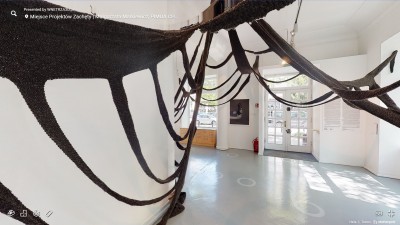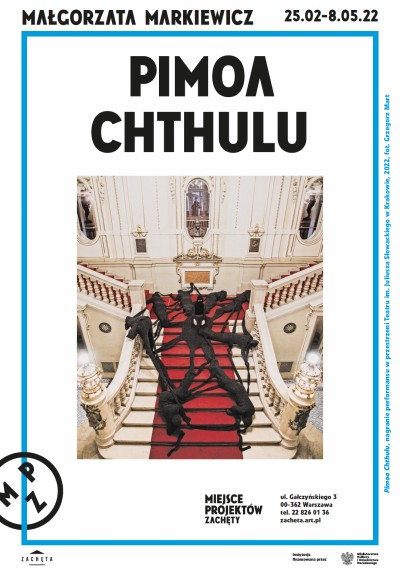Małgorzata Markiewicz Pimoa Chthulu
25.02 – 08.05.2022 Małgorzata Markiewicz Pimoa Chthulu
Building a non-linear, multi-threaded, branching structure is the daily bread of spiders. These systems can be disturbed, psychedelic and dark. The lack of a single ordering, linear and certain narrative, as well as constant anomalies and surprises create chaos, but also order. Just as the Cosmos is the resultant of chaos and order. In this project, I am interested in imagined interpersonal networks, built in tension between the gestures of two, three or many people. These structures bind us into loving, hateful and toxic systems, their sticky threads clinging to a body flitting in the dance of life towards death. The sequences of chance and effect do not necessarily follow one another clearly, time and again something very surprising or rather, in our opinion, nonsensical happens.
(Małgorzata Markiewicz on the idea of the project)
Motifs of a web (including a spider’s web) with metaphorical meaning have appeared in Małgorzata Markiewicz’s work before. In 2003, the artist showed an object and a series of self-portraits in a net-dress (Cobweb) at an exhibition at Potocka Gallery. The protagonist of the photos could have been taken for a temptress (her naked body shone through the netting), although another viewer would have seen her as a victim who fell into a net. Her diploma project Fragment of the Coexistence Net from 2004 consisted of shells/garments with very long legs/sleeves of different colours — with the colours of one sleeve flowing seamlessly into the colouring of the leg of the next link. The models/performers dressed in them formed, as the author writes, a kind of network. Critics described this work using the metaphor of a system of interpersonal relationships or interdependencies or influences — both good and limiting, but without which people as social beings could not exist.
2004 also saw the creation of The Net, an installation of crocheted schematic human silhouettes that together formed an intricate arrangement. On the other hand, in the exhibition Handicrafts at the Władysław Hasior Gallery (2019, together with Katarzyna Depta-Garapich), Markiewicz presented a spiderweb made of leather entitled Cosmos. This time it was a kind of tribute to the founder of the lace-making school, Karol Kłosowski, and to master craftsmen in general.
A project with similar sources of inspiration, the 2020 Medusa is a Medusa body crocheted in honour of the creative female force that any woman can put on to tell her story, and the tentacles of the mythical monster are free to connect with other beings. In addition to recent works, the artist’s work entitled Under Toxic (2016) in the form of wall collages made of carpets also hangs on the walls of the Zachęta Project Room. The artist introduces an element of anxiety into the tapestries she collects, depicting genre scenes and kitschy images of happy lands, by overlaying them with motifs of spider webs. Their patterns were inspired by the distorted webs made by spiders exposed to various psychoactive substances used in humans for stimulation or treatment — such as chloral hydrate, Benzedrine, marijuana or caffeine. In the descriptions of these works, there were obvious references to the myth of Arachne as a metaphor for female destiny and weaving (whether a web or a piece of fabric) as a symbol of creativity in general. The artist herself likes to evoke the beliefs of the Hopi Indians and their story of the creation of the world by the Spider Grandmother, who then taught the people the art of basket weaving.
The use of crochet and sewing techniques, transforming clothes into art objects, expanding the boundaries of the concept of artistic textiles — these are Małgorzata Markiewicz’s trademarks. A graduate of the Faculty of Sculpture, she creates three-dimensional objects, usually — but not exclusively — from soft materials (yarn, fabric). She also uses performance, photography and film to build her conceptual projects. The themes she explores mostly concern the identity and social position of women. She makes frequent references to everyday life, domestic activities, especially those perceived as typically feminine. Threads from the sphere of ‘ordinariness’ and household chores smuggle in hidden meanings — for example, the distribution of social roles in traditional societies is ironically discussed, and femininity is also perceived through eroticism, not only through the prism of caring for the home. Markiewicz also explores the complexities of interpersonal relationships. Her most recent projects refer to more universal themes, such as the contemporary condition of the world, threats and possibilities of repair seen from the perspective of women and the eternal forces within them.
Pimoa Chthulu is a project prepared especially for the exhibition at the Zachęta Project Room. The main part of the exhibition is a large-scale object made of black sheep’s wool — resembling a spider web, an octopus or human bodies joined together. The sculpture was made using crochet techniques by the artist and women of different ages and from different localities, acting as the Spider Grandmother. Collaboration with other artists or craftspeople in the creation of projects is another distinguishing feature of Małgorzata Markiewicz’s creative method. (Her earlier works already featured the theme of invisible women’s work or work as a social value that brings income and self-reliance). This time, the artist’s Facebook ad was answered by pensioners, women looking for employment, often in difficult life situations. The artist treats them as partners, not anonymous subcontractors. This is evidenced by the fact that portraits of all the project participants (including Małgorzata Markiewicz Pimoa Chthulu the author) with oversized crochet hooks under their arms, taken using the black and-white photography technique, occupy an important place in the exhibition. The author of the photographs is Michał Łuczak. I hope that the fees for their work have helped the budgets of the ‘spiders’, and that the collaboration on the artistic project has allowed them to taste the joy of creation, at least for a while. Markiewicz’s work is sometimes referred to as social sculpture or participatory art. The interaction and the resulting interpersonal relationships are as important to the author as the end result itself — the work of art. In the underground part of the gallery, there is a video projected which presents the created object in motion (the individual parts of the sculpture can be entered as if it was a cocoon). The recording was made in the Juliusz Słowacki Theatre in Kraków with the participation of invited performers and the artist herself. A black, fear-inducing — because of its disturbingly species-indeterminate nature — organic creature moves through the richly decorated ‘palace’ interiors and makes violent convulsive movements. The music accompanying the performers was composed by Bartosz Zaskórski — Małgorzata’s friend, visual artist, composer and musician. The source material for the resulting samples are violin improvisations performed by another artist, Piotr Lutyński. Wild highlander notes can be clearly heard in the recording. The trance-like sounds and movements of the figure can evoke fear and fascination, as in the case of a spectator watching magical rituals of expelling evil spirits from the possessed. The artist cites as one of her sources of inspiration the tarantella, a folk dance from Apulia in southern Italy, inspired by the movements of a person bitten by a spider and intended to lead to purification. She writes,
The tarantella was/is called the dance of the spider or the dance of the person bitten by the spider [considered] as a folk way to expel the venom from the soul of the person bitten. Under the cover of the ‘spider bite’ were all mental problems (diseases of the soul) such as depression, mania, hysteria, sadness and marasmus. The treatment involved dancing the venom out of the body. A group of musicians would come to the sick person and try to play melodies of different tempo and rhythm so as to find the one that suited the state of the sick person’s soul. When this was successful, a trance dance followed.
Another important source of inspiration for Markiewicz’s latest project is a motif from the novel Cosmos by Witold Gombrowicz. (It is worth mentioning that the artist is the author of the Kraków monument devoted to this writer). Witold, who is visiting Zakopane with a friend, becomes a victim of his own investigation. The author comments, ‘The signs that form a series catch him in their snares like a spider’s web catches a fly. Attempts to draw conclusions, to solve the puzzle in a logical manner come to nothing. The protagonist must confront the unknown, the unrecognisable, the disorderly, the illogical and the fearful’. Markiewicz explains the title of the exhibition as follows:
Pimoa Chthulu is the name of the leading fictional spider figure in Donna J. Haraway’s philosophy, a modified version of the taxonomic name of the actually existing Pimoa cthulhu spider living in California, [which] comes from the language of the indigenous Goshute people of Utah: Pimoa — big legs, Cthulhu — akin to the powers of Chaos. In Haraway’s modified second part ‘chthulu’ is derived from the word ‘chthonic’, meaning coming from the subterranean world powering all that lives. The Chthulucene (another term from Haraway’s philosophy) is the era in which we now live, in which it will be crucial to our survival to seek connections and relationships with non-human beings and plants, that is, to look for ‘relatives’ not necessarily among humans. . . . Pimoa Chthulu contains the entire subterranean world giving life to what is above it, feeding fungi, plants, animals and humans, which is built on the principle of connections. Everything is connected to something, and that something is connected to something else. And death and life happen within these connections.
For Małgorzata Markiewicz, the metaphor of the spiderweb becomes crucial in describing her latest project resulting from the reflection on the human condition from a planetary perspective.
Magda Kardasz
translated by Paulina Bożek
MAŁGORZATA MARKIEWICZ — graduate of the Faculty of Sculpture at the Academy of Fine Arts in Kraków (diploma in 2004). She received her Ph. D. degree in 2015. She studied at Konstfack and at the Critical Design Studio at the Faculty of Architecture of Kungliga Tekniska högskolan in Stockholm. Currently, she is a lecturer at the Institute of Art and Design of the Pedagogical University in Kraków. Lives and works in Kraków.
Małgorzata Markiewicz
Pimoa Chthulu
25.02 – 08.05.2022
Zachęta Project Room
ul. Gałczyńskiego 3, 00-362 Warsaw
See on the map
Godziny otwarcia:
tuesday–Sunday 12–8 p.m.
free entry


